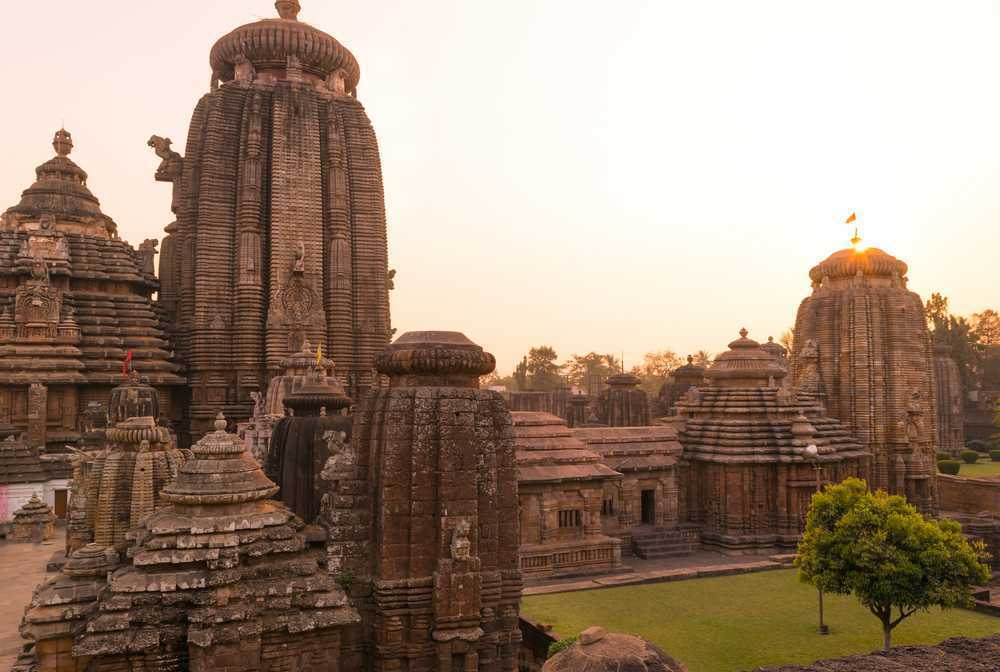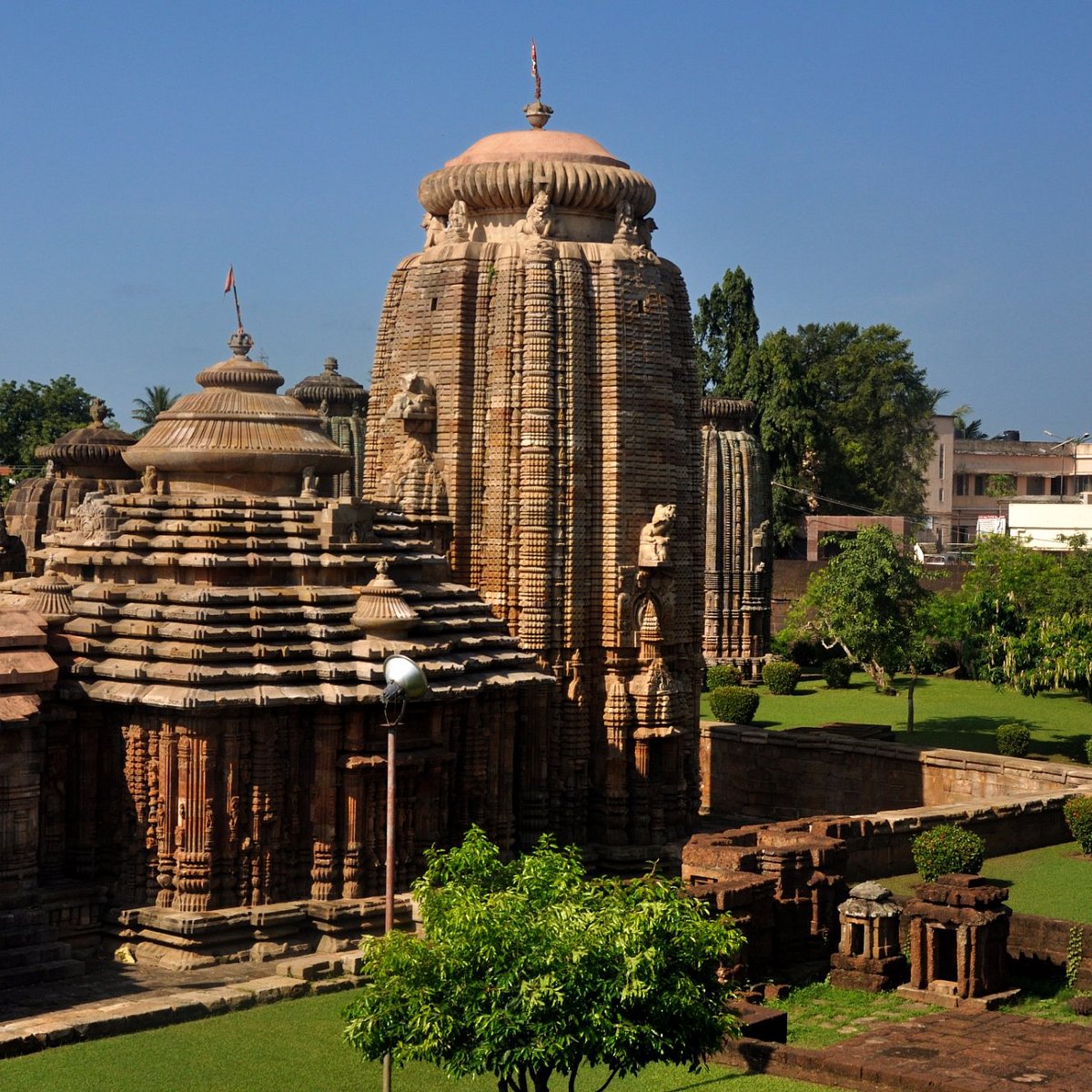


Maha-Lingraj Temple
The largest of the temples in Bhubneswar is the Lingaraj temple,
which is an outstanding specimen of the Odisha style of temple building. The
temple is the most prominent landmark of Bhubaneswar city and one of the major
tourist attractions of the state. The temple is dedicated to Bhagwan Shiva. James Fergusson (1808–86), a noted critic and
historian rated the temple as "one of the finest examples of purely Hindu
temple in India".
The temple is
believed to be built in the eleventh century by the king Yayati
I (1025-1040) from
the Somavamsi dynasty, with later additions from
the Ganga rulers. The temple is built in
the Deula style
that has four components namely, vimana
(structure containing the sanctum), jagamohana (assembly
hall), natamandira (festival
hall) and bhoga-mandapa (hall
of offerings), each increasing in the height to its predecessor.
Each inch of the 55 m (180 ft) tall tower is sculpted. The
door in the gate of the entrance porch is made of sandalwood. The lofty walls of the temple are
constructed using solid red sandstone, lending it the look of a fortress, from
the exterior. The Lingaraja temple faces east and is built of sandstone and laterite. The main entrance is located in the east, while there are
small entrances in the north and south.
The shrine is
devoted to the worship of Harihara (a combined form of Vishnu and Shiva) in the
form of a Linga and His consort Bhubaneshvari. The Deity is also known as
Tribhuvaneshvara (or Bhubaneshvara), the Lord of the three worlds. The temple
complex has 50 other shrines and is enclosed by a large compound wall.
The Lingaraja temple is located in an expansive courtyard
covering over 2, 50,000 square feet and is surrounded by fortified walls.
The Shiva Linga which is 8 feet in diameter is at the sanctum
of the Lingaraja temple. To the northwest of the courtyard is the
Bhagawati temple. The thirteenth century tradition of providing meals to 51
priests and 51 underprivileged persons everyday continues even now.
The lingam in
the temple is a natural unshaped stone that rests on a Sakti. Such a lingam is
called Krutibasa or Swayambhu and is found in 64 places in different parts of
India.
The Gangas
remodelled the temple and introduced certain Vaishnavite elements like images
of Vaishnava Dwarapalas namely Jaya and Prachanda, The flag of the temple was
fixed to a Pinaka bow instead of trident usually found In Shiva temples.
The temple
has an average of 6,000 visitors per day and receives lakhs of visitors during
festivals. Shivaratri festival is the major festival celebrated in
the temple. The temple compound is not open to non-Hindus, but there is a
viewing platform beside the wall offering a good view of the main exteriors.
This was originally erected for a visit by Lord Curzon then Viceroy.
The bhogamandapa (Hall
of offering) measures 42 ft *42 ft from the inside, The exterior
walls of the hall has decorative sculptures of men and beast. The hall has a
pyramidal roof made of up several horizontal layers arranged in sets of two
with intervening platform. It bears an inverted bell and a kalasa in
the top. The natamandira (festival hall) measures
38 ft*38 ft from the inside, The side walls of the hall have
decorative sculptures displaying women and couples. It has a flat roof sloping
in stages. There are thick pylons inside the hall. The jagamohana (assembly
hall) measures 35 ft *30 ft from the inside. The hall has a pyramidal
roof made of up several horizontal layers arranged in sets of two with
intervening platform as in the Hall of offering. The facades to the entrances
are decorated with perforated windows with lion sitting on hind legs. The
inverted bell above second unit is adorned by kalasa and
lions. The rekha deula has a 200 ft tall pyramidal
tower over the sanctum and measures 22 ft*22 ft from the inside, It
is covered with decorative design and seated lion projecting from the walls.
The sanctum is square in shape from the inside. The tower walls are sculpted
with female figures in different poses.
As per Hindu
legend, an underground river originating from the Lingaraja temple fills
the Bindusagar Tank (meaning ocean drop) and
the water is believed to heal physical and spiritual illness. The water from
the tank is thus treated sacred and pilgrims take a holy dip during festive
occasions.
Shivaratri is the main festival celebrated annually in Phalgun month
when thousands of devotees visit the temple. Apart from a full day of
fasting, bel leaves are offered to Lingaraja on this
auspicious day. The main celebrations take place at night when devotees pray
all night long. The devout usually break their fast after the Mahadipa (a
huge lamp) is lit on the spire of the temple. This festival commemorates
Lingaraja having slain a demon. Thousands of bol bom pilgrims
carry water from river Mahanadi and walk all the way to the temple during the month of
Shravana every year.
Every year
the chariot festival (Ratha-Yatra) of Lingaraja is celebrated
on Ashokashtami. The deity is taken in a chariot to Rameshwar
Deula temple. Thousands of devotees follow and pull brightly
decorated chariots containing the idols of Lingaraja, Gopaluni and Vasudeva.
The image of
Lingaraja is abluted with water (called mahasnana) several times a
day and decorated with flowers, sandal paste and cloth. Hemlock flowers which are generally offered in other Shiva
temples is not allowed in the Lingaraja temple. Bilva leaves and tulasi are used in daily worship. Offerings of cooked
rice, curries and sweets are displayed in the bhogamandapa and
the divinity is invoked to accept them amidst scores of chanting of Sanskrit
texts. The Lingaraja temple is open from 6 a.m. to about 9 p.m. and is
intermittently closed during bhoga (food offering) to the
deity.







